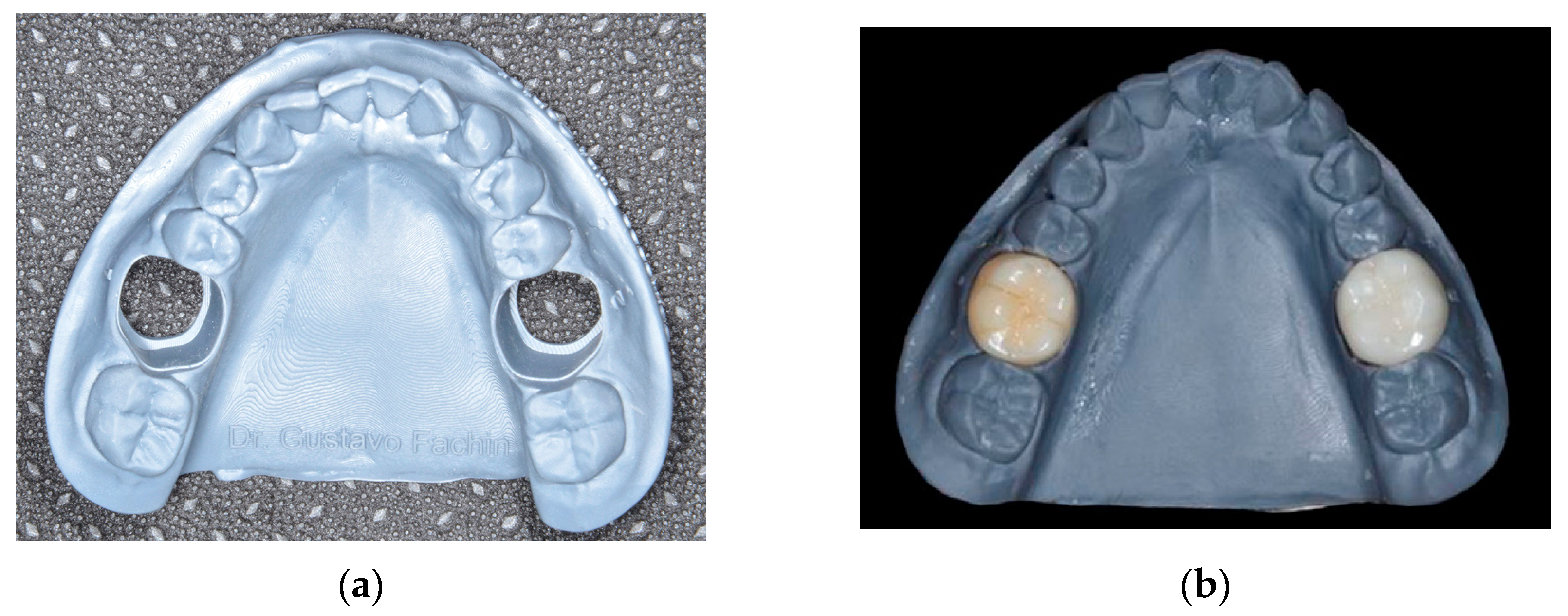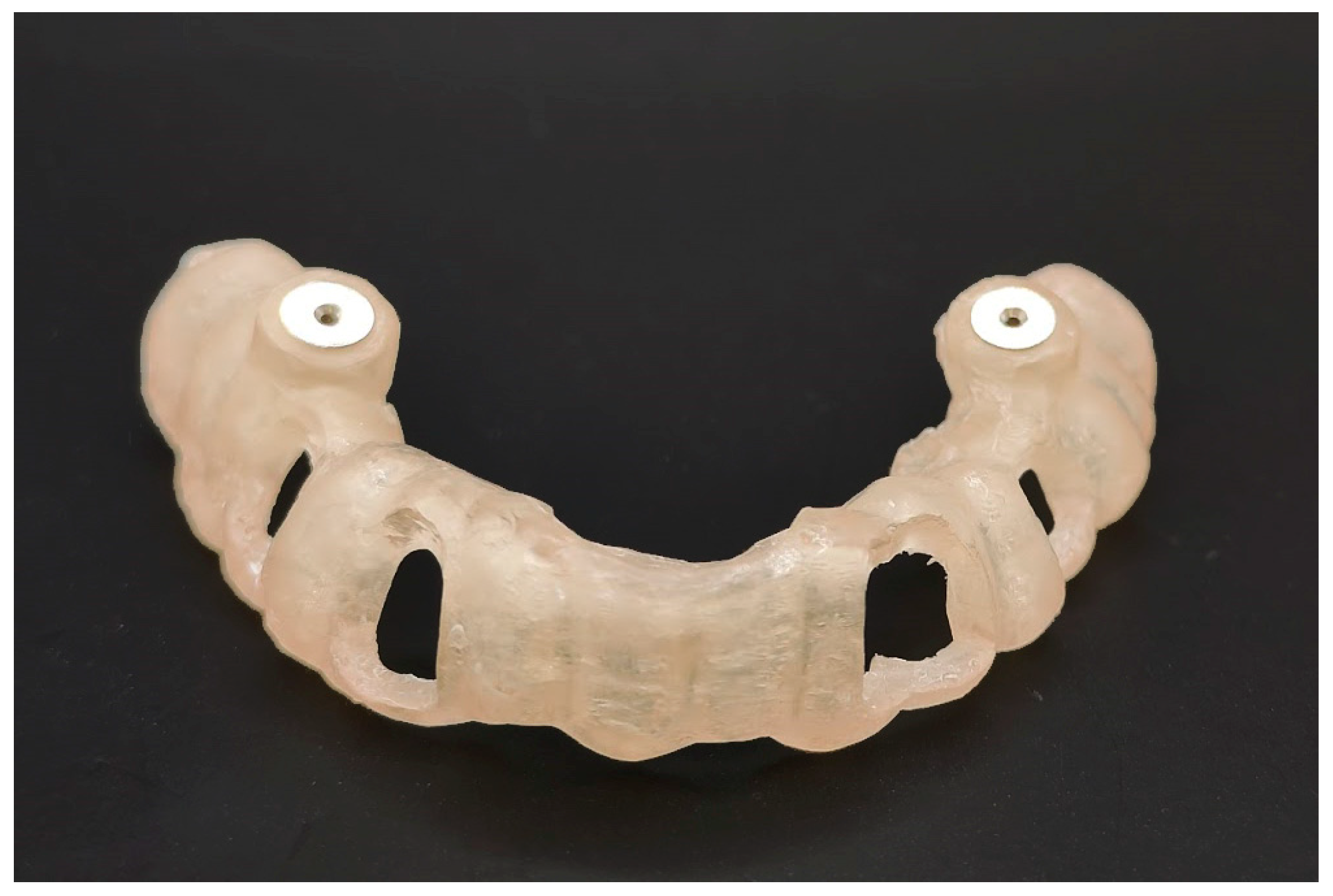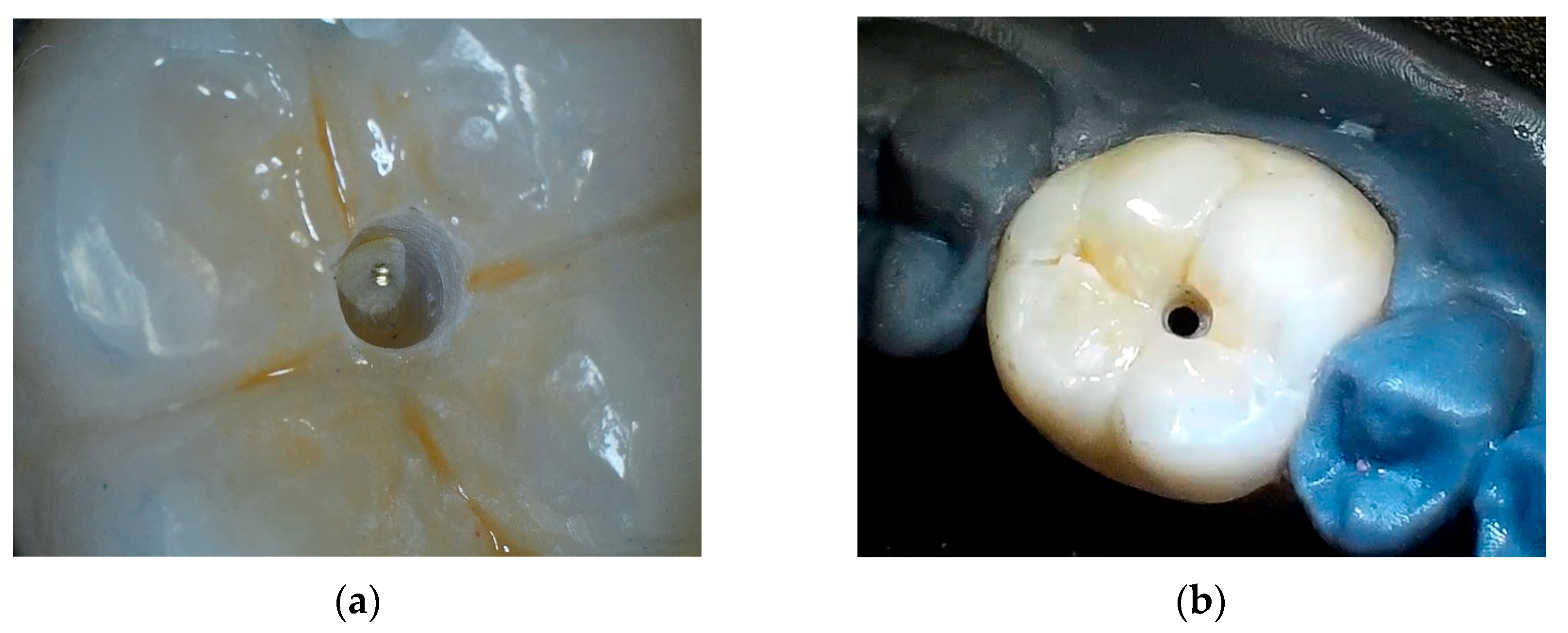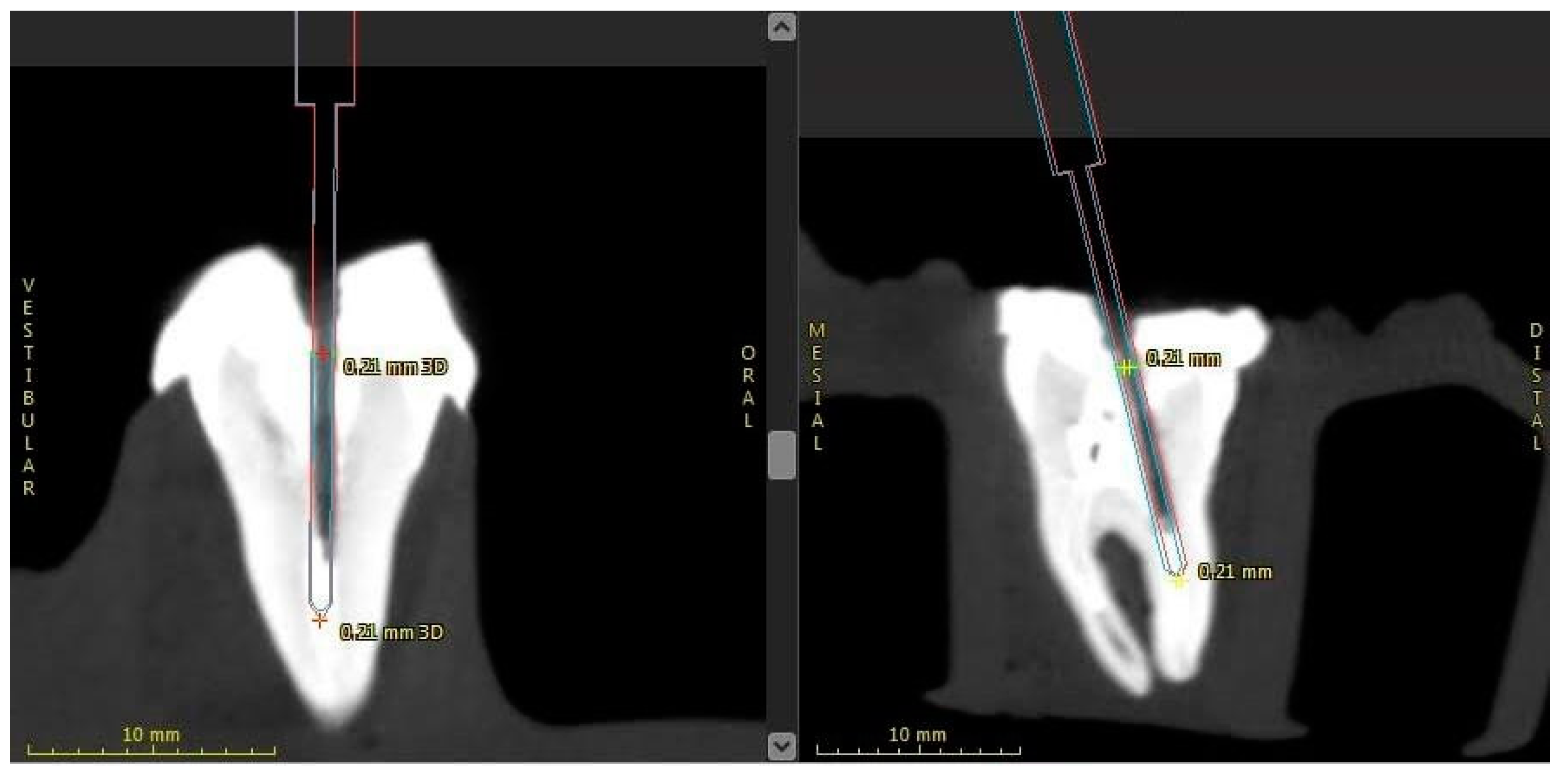Guided Access through Ceramic Crowns with Fiberglass Post Removal in Lower Molars: An In Vitro Study
Abstract
Featured Application
Abstract
1. Introduction
2. Materials and Methods
2.1. Sample Calculation
2.2. Selection and Preparation of Teeth
2.3. Model Preparation
2.4. Virtual Planning
2.5. Procedure
2.6. Evaluation of Accuracy
2.7. Statistical Analysis
3. Results
4. Discussion
5. Conclusions
Author Contributions
Funding
Institutional Review Board Statement
Informed Consent Statement
Data Availability Statement
Conflicts of Interest
References
- Ng, Y.L.; Mann, V.; Gulabivala, K. Outcome of secondary root canal treatment: A systematic review of the literature. Int. Endod. J. 2008, 41, 1026–1046. [Google Scholar] [CrossRef] [PubMed]
- Ruskin, J.D.; Morton, D.; Karayazgan, B.; Amir, J. Failed root canals: The case for extraction and immediate implant placement. J. Oral Maxillofac. Surg. 2005, 63, 829–831. [Google Scholar] [CrossRef]
- Garcia-Guerrero, C.; Parra-Junco, C.; Quijano-Guauque, S.; Molano, N.; Pineda, G.A.; Marin-Zuluaga, D.J. Vertical root fractures in endodontically-treated teeth: A retrospective analysis of possible risk factors. J. Investig. Clin. Dent. 2018, 9, e12273. [Google Scholar] [CrossRef]
- Riis, A.; Taschieri, S.; Del Fabbro, M.; Kvist, T. Tooth Survival after Surgical or Nonsurgical Endodontic Retreatment: Long-term Follow-up of a Randomized Clinical Trial. J. Endod. 2018, 44, 1480–1486. [Google Scholar] [CrossRef] [PubMed]
- Scribante, A.; Vallittu, P.K.; Ozcan, M. Fiber-Reinforced Composites for Dental Applications. BioMed Res. Int. 2018, 2018, 4734986. [Google Scholar] [CrossRef] [PubMed]
- Sarkis-Onofre, R.; Amaral Pinheiro, H.; Poletto-Neto, V.; Bergoli, C.D.; Cenci, M.S.; Pereira-Cenci, T. Randomized controlled trial comparing glass fiber posts and cast metal posts. J. Dent. 2020, 96, 103334. [Google Scholar] [CrossRef]
- Figueiredo, F.E.; Martins-Filho, P.R.; Faria, E.S.A.L. Do metal post-retained restorations result in more root fractures than fiber post-retained restorations? A systematic review and meta-analysis. J. Endod. 2015, 41, 309–316. [Google Scholar] [CrossRef]
- Lang, H.; Korkmaz, Y.; Schneider, K.; Raab, W.H. Impact of endodontic treatments on the rigidity of the root. J. Dent. Res. 2006, 85, 364–368. [Google Scholar] [CrossRef]
- Connert, T.; Krug, R.; Eggmann, F.; Emsermann, I.; ElAyouti, A.; Weiger, R.; Kuhl, S.; Krastl, G. Guided Endodontics versus Conventional Access Cavity Preparation: A Comparative Study on Substance Loss Using 3-dimensional-printed Teeth. J. Endod. 2019, 45, 327–331. [Google Scholar] [CrossRef]
- Wood, K.C.; Berzins, D.W.; Luo, Q.; Thompson, G.A.; Toth, J.M.; Nagy, W.W. Resistance to fracture of two all-ceramic crown materials following endodontic access. J. Prosthet. Dent. 2006, 95, 33–41. [Google Scholar] [CrossRef]
- Lund, C.; Guevara, P. The effect of endodontic access on the failure load of lithium disilicate and resin nanoceramic CAD/CAM crowns. Gen. Dent. 2018, 66, 54–59. [Google Scholar]
- Wiegand, A.; Kanzow, P. Effect of Repairing Endodontic Access Cavities on Survival of Single Crowns and Retainer Restorations. J. Endod. 2020, 46, 376–382. [Google Scholar] [CrossRef] [PubMed]
- Lynch, C.D.; Hale, R.; Chestnutt, I.G.; Wilson, N.H.F. Reasons for placement and replacement of crowns in general dental practice. Br. Dent. J. 2018, 225, 229–234. [Google Scholar] [CrossRef]
- Zehnder, M.S.; Connert, T.; Weiger, R.; Krastl, G.; Kuhl, S. Guided endodontics: Accuracy of a novel method for guided access cavity preparation and root canal location. Int. Endod. J. 2016, 49, 966–972. [Google Scholar] [CrossRef] [PubMed]
- Krastl, G.; Zehnder, M.S.; Connert, T.; Weiger, R.; Kuhl, S. Guided Endodontics: A novel treatment approach for teeth with pulp canal calcification and apical pathology. Dent. Traumatol. 2016, 32, 240–246. [Google Scholar] [CrossRef]
- Van Der Meer, W.J.; Vissink, A.; Ng, Y.L.; Gulabivala, K. 3D Computer aided treatment planning in endodontics. J. Dent. 2016, 45, 67–72. [Google Scholar] [CrossRef] [PubMed]
- Buchgreitz, J.; Buchgreitz, M.; Mortensen, D.; Bjorndal, L. Guided access cavity preparation using cone-beam computed tomography and optical surface scans-An ex vivo study. Int. Endod. J. 2016, 49, 790–795. [Google Scholar] [CrossRef] [PubMed]
- Connert, T.; Zehnder, M.S.; Weiger, R.; Kuhl, S.; Krastl, G. Microguided Endodontics: Accuracy of a Miniaturized Technique for Apically Extended Access Cavity Preparation in Anterior Teeth. J. Endod. 2017, 43, 787–790. [Google Scholar] [CrossRef]
- Lara-Mendes, S.T.O.; Barbosa, C.F.M.; Machado, V.C.; Santa-Rosa, C.C. A New Approach for Minimally Invasive Access to Severely Calcified Anterior Teeth Using the Guided Endodontics Technique. J. Endod. 2018, 44, 1578–1582. [Google Scholar] [CrossRef]
- Schwindling, F.S.; Tasaka, A.; Hilgenfeld, T.; Rammelsberg, P.; Zenthofer, A. Three-dimensional-guided removal and preparation of dental root posts-concept and feasibility. J. Prosthodont. Res. 2020, 64, 104–108. [Google Scholar] [CrossRef]
- Aydin, B.; Pamir, T.; Baltaci, A.; Orman, M.N.; Turk, T. Effect of storage solutions on microhardness of crown enamel and dentin. Eur. J. Dent. 2015, 9, 262–266. [Google Scholar] [CrossRef] [PubMed]
- Buchgreitz, J.; Buchgreitz, M.; Bjorndal, L. Guided root canal preparation using cone beam computed tomography and optical surface scans-An observational study of pulp space obliteration and drill path depth in 50 patients. Int. Endod. J. 2019, 52, 559–568. [Google Scholar] [CrossRef] [PubMed]
- Laederach, V.; Mukaddam, K.; Payer, M.; Filippi, A.; Kuhl, S. Deviations of different systems for guided implant surgery. Clin. Oral Implant. Res. 2017, 28, 1147–1151. [Google Scholar] [CrossRef]
- Perez, C.; Finelle, G.; Couvrechel, C. Optimisation of a guided endodontics protocol for removal of fibre-reinforced posts. Aust. Endod. J. 2019, 46, 107–114. [Google Scholar] [CrossRef]
- Gorman, C.M.; Ray, N.J.; Burke, F.M. The effect of endodontic access on all-ceramic crowns: A systematic review of in vitro studies. J. Dent. 2016, 53, 22–29. [Google Scholar] [CrossRef]
- Gerogianni, P.; Lien, W.; Bompolaki, D.; Verrett, R.; Haney, S.; Mattie, P.; Johnson, R. Fracture Resistance of Pressed and Milled Lithium Disilicate Anterior Complete Coverage Restorations Following Endodontic Access Preparation. J. Prosthodont. 2019, 28, 163–170. [Google Scholar] [CrossRef] [PubMed]
- El Kholy, K.; Lazarin, R.; Janner, S.F.M.; Faerber, K.; Buser, R.; Buser, D. Influence of surgical guide support and implant site location on accuracy of static Computer-Assisted Implant Surgery. Clin. Oral Implants Res. 2019, 30, 1067–1075. [Google Scholar] [CrossRef]
- Tahmaseb, A.; Wismeijer, D.; Coucke, W.; Derksen, W. Computer technology applications in surgical implant dentistry: A systematic review. Int. J. Oral Maxillofac. Implants 2014, 29 (Suppl.), 25–42. [Google Scholar] [CrossRef]
- Pessoa, R.; Siqueira, R.; Li, J.; Saleh, I.; Meneghetti, P.; Bezerra, F.; Wang, H.L.; Mendonca, G. The Impact of Surgical Guide Fixation and Implant Location on Accuracy of Static Computer-Assisted Implant Surgery. J. Prosthodont. 2022, 31, 155–164. [Google Scholar] [CrossRef] [PubMed]
- Mendes, E.B.; Soares, A.J.; Martins, J.N.R.; Silva, E.; Frozoni, M.R. Influence of access cavity design and use of operating microscope and ultrasonic troughing to detect middle mesial canals in extracted mandibular first molars. Int. Endod. J. 2020, 53, 1430–1437. [Google Scholar] [CrossRef]




| Inexperienced Operator (IN) | Experienced Operator (Ex) | Difference | p * | |
|---|---|---|---|---|
| Mean (SD) Median [min–max] | Mean (SD) Median [min–max] | Mean [CI 95%] | ||
| Angle | 2.54° (1.371) 2.7° [0–5.85] | 1.55° (0.791) 1.82 [0–2.85] | 0.998 [0.281–1.714] | 0.008 |
| 3D deviation | 0.44 mm (0.174) 0.45 mm [0.14–0.73] | 0.33 mm (0.178) 0.31 mm [0.11–0.76] | 0.113 [0.001–0.226] | 0.049 |
Disclaimer/Publisher’s Note: The statements, opinions and data contained in all publications are solely those of the individual author(s) and contributor(s) and not of MDPI and/or the editor(s). MDPI and/or the editor(s) disclaim responsibility for any injury to people or property resulting from any ideas, methods, instructions or products referred to in the content. |
© 2023 by the authors. Licensee MDPI, Basel, Switzerland. This article is an open access article distributed under the terms and conditions of the Creative Commons Attribution (CC BY) license (https://creativecommons.org/licenses/by/4.0/).
Share and Cite
Fachin, G.F.; Dinato, T.R.; Prates, F.B.; Connert, T.; Pelegrine, R.A.; Bueno, C.E.d.S. Guided Access through Ceramic Crowns with Fiberglass Post Removal in Lower Molars: An In Vitro Study. Appl. Sci. 2023, 13, 5516. https://doi.org/10.3390/app13095516
Fachin GF, Dinato TR, Prates FB, Connert T, Pelegrine RA, Bueno CEdS. Guided Access through Ceramic Crowns with Fiberglass Post Removal in Lower Molars: An In Vitro Study. Applied Sciences. 2023; 13(9):5516. https://doi.org/10.3390/app13095516
Chicago/Turabian StyleFachin, Gustavo Freitas, Thiago Revillion Dinato, Frederico Ballvé Prates, Thomas Connert, Rina Andrea Pelegrine, and Carlos Eduardo da Silveira Bueno. 2023. "Guided Access through Ceramic Crowns with Fiberglass Post Removal in Lower Molars: An In Vitro Study" Applied Sciences 13, no. 9: 5516. https://doi.org/10.3390/app13095516
APA StyleFachin, G. F., Dinato, T. R., Prates, F. B., Connert, T., Pelegrine, R. A., & Bueno, C. E. d. S. (2023). Guided Access through Ceramic Crowns with Fiberglass Post Removal in Lower Molars: An In Vitro Study. Applied Sciences, 13(9), 5516. https://doi.org/10.3390/app13095516








